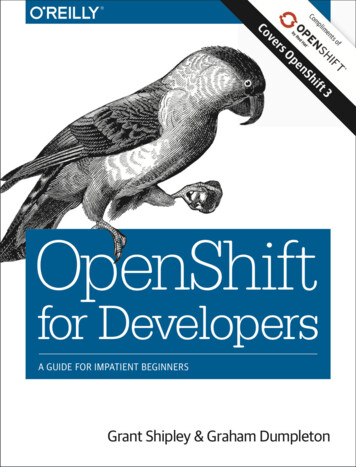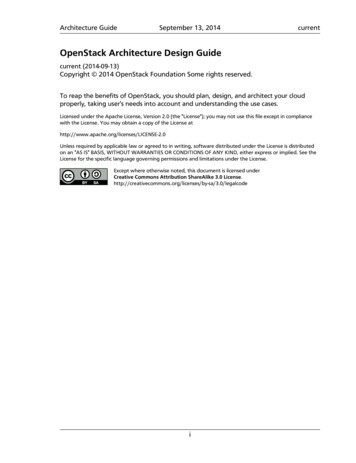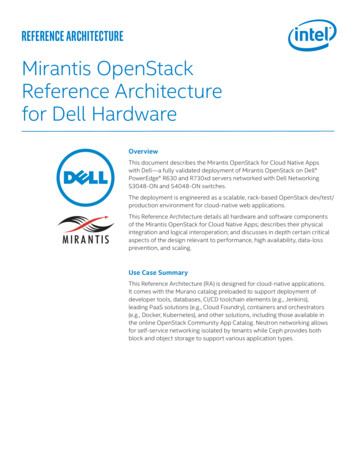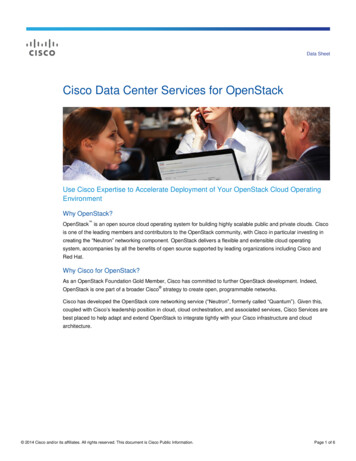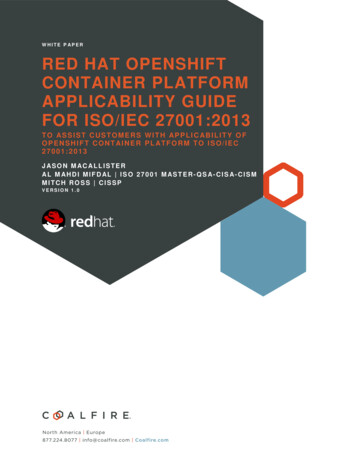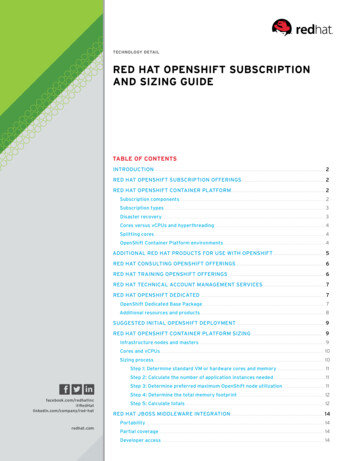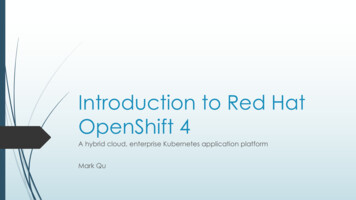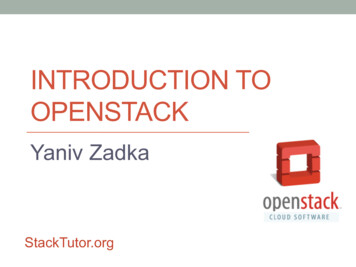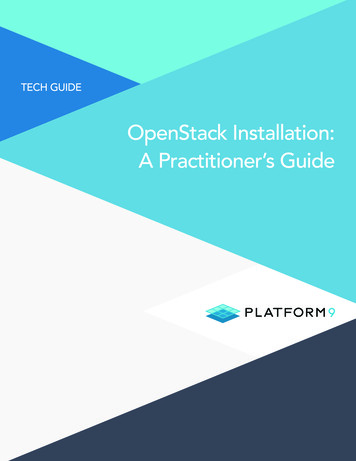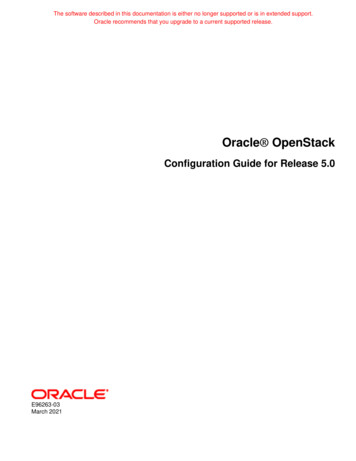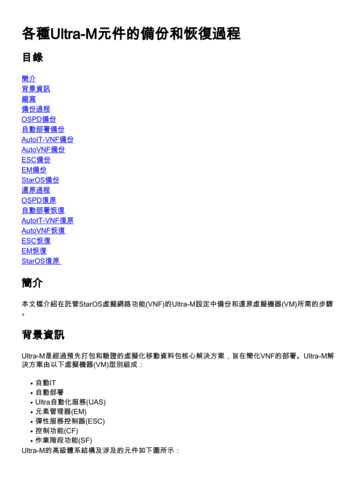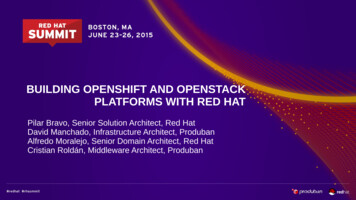
Transcription
BUILDING OPENSHIFT AND OPENSTACKPLATFORMS WITH RED HATPilar Bravo, Senior Solution Architect, Red HatDavid Manchado, Infrastructure Architect, ProdubanAlfredo Moralejo, Senior Domain Architect, Red HatCristian Roldán, Middleware Architect, Produban
WHO WE ARE
WHO IS WHOPILAR BRAVOCRISTIAN ROLDANSenior Solution ArchitectJBoss MiddlewareMiddleware ArchitectALFREDO MORALEJODAVID MANCHADOSenior Cloud Domain ArchitectInfrastructure Architect
PRODUBAN 5.000 professionalsA Global Company in 9 countries giving services to 120 Santander Group affiliates
SERVICES PROVIDED.117 million Retail Banking Customers11.6 million Online Banking Customers30 million of credit cards80 million of debit cards30 million Contact Centre calls a month1,258 million of weekly transactions67 million of card transaction during peak days2.4 million weekly batch executions16.7 million of daily paymentsON TOP OF.10 Corporate Datacenters15 Mainframes 28,000 physical servers 64,000 logical servers 22,000 data bases 28,000 web app servers 12,900 branches 253,000 desktops 6 PB/M data btw DC
GLOBAL CLOUD PROJECT Aims to provide a full XaaS stackAlready existing services– IaaS– PaaS– Enable digital transformation (Banking 3.0) DevOps Mobile Apps
THE WHOLE PICTURE
BUILDING AN OPENSTACK PLATFORM
DESIGN PRINCIPLESGreenfield approachGeneral-purpose CloudSoftware Defined EverythingMultilocationScale-outFailure domain contentionVendor lock-in avoidanceOpen StandardsOpenSource First (.but not only!)
DECISSION MAKING PROCESS: OPENSTACKWHY y–Upgrade-in-place (starting from Icehouse)–Technology meeting point (de-factostandard)WHY RED HAT–Close relationship since 2010–Major player in OpenStack–Professional Service offering–Support
DECISSION MAKING PROCESS: SERVERSOpenstack ServicesCompute NodesVMwareKVMTraditional Standalone ServerOpenComputeLocal diskLocal disk (Ceph)–Efficiency–Data Center strategy–Openhttp://www.opencompute.org
DECISSION MAKING PROCESS: STORAGESoftware Defined StorageMultiple storage needs (image, block & object)Scale-outOpenstack alignmentMaximum usage of available resourcesOpenSource reference solution for OpenStackFlexibilityPay as you growSupported by Red Hat.and it works!
DECISSION MAKING PROCESS: NETWORKINGSoftware Defined NetworkNon-propietary fabricBased on standard routing protocols (OSPF)Leaf & Spine topologyScalabilityOpenstack alignmentAvoid L2 adjacencyFederation CapabilitiesDistributed routingMaturitySupport
MULTILOCATION DEPLOYMENT Located on Corporate DataCenters Traditional failure domain approach1. Region2. Availability Zone (AZ)RegionAZAZAZ Provide building blocks to define resilientarchitectures on topAZAZAZRegionAZAZAZRegionAZAZAZRegion
HIGH LEVEL DESIGNPublic CloudRed Hat CloudFormsSATELLITE 6Red Hat Enterprise LinuxOpenStack Platform(orchestration,automation andpatch management)Horizon (Dashboard)GLANCECEPHCINDERBlock StoreSWIFTObject sorHardwareNOVAComputeKEYSTONEID ManagementCEILOMETERMetering
SIZINGCURRENTLYBiggest region:88 compute nodes / 44 ceph OSD nodes (440 x 4TB OSDs)Smallest region:8 compute nodes / 8 ceph OSD nodes ( 80 x 4TB OSDs)Total deployed: 160 compute nodes / 12 ceph OSD nodes (120 x 4TB OSDs)MID TERM14,000CORES200TBRAM600TBOSD JOURNAL16PBOSD CAPACITYThink big, start small plan to grow to 1000 nodes
CLOUD VERSIONINGv0v0.1v1.0 Betav1.0
TECHNICAL CHALLENGES Think big, start small Maximize resource usage Non-cloud native workloads Big Data Availability Zones isolation Live Architecture Heterogeneous components integration and lifecycle (HW, Openstack, SDS, SDN ) Non-openstack ecosystem integration (monitoring, billing, identity provider.)
DEPLOYMENT ARCHITECTURE Distribute control plane in following roles: Load Balancers: haproxy Backend: MariaDB, MongoDB, RabbitMQ Controllers: OpenStack servicesPacemaker as cluster managerGalera for MariaDB replicationRabbitMQ with mirrored queuesAdditional per-AZ cluster with cinder
RESOURCE DISTRIBUTION Goal: maximize hardware resources usage Hyperconvergent mode not recommended by Red Hat. Approach: stability over performance Limit resources usage (specially memory) for ceph (OSDs) and nova (VMs):–cgroups to limit memory used by OSDs ( 40GB)–Reserved host memory mb to reduce the memory for nova scheduler ( 50GB)–Use cinder QoS to limit per-volume resources–Distribution of available network bandwith for different workflows (QoS)
CEPH DESIGNREGIONJBOD 14 x SATA/SSD800G SSD150G Journal150G Journal150G Journal150G Journal60G OSRAID1OSDSATA 4TBOSDSATA 4TBOSDSATA 4TBOSDSATA 4TBSATA 4TB800G SSDOSDSATA 4TBOSDSATA 4TB150G JournalOSDSATA 4TB60G OSRAID1OSDSATA 4TB150G Journal150G JournalAZ2AZ3ZONEZONEZONESSD 1,6TBSATA 4TB150G JournalAZ1RACKRAID RAGESERVERSTORAGESERVERSTORAGESERVERCache pool/ poolSSD 1,6TBSSD 1,6TB123SATA 4TB3 Copies using a rule placing all copies in different racks and zones inside a given AZ/RegionOSD
THE DATA ANALYTICS CHALLENGE Critical use case: big data with hadoop and HDFS– Designedand conceived for bare metal with local disks Created several big flavors for analytics Main challenge: I/O access for HDFSIronicPCI- PassthroughCinderSwiftEphemeralCeph driver
THE DATA ANALYTICS CHALLENGE (II) Defined non-converged nodes with local disks in a Host Aggregate Assigned extra specs to analytics flavors to schedule in non-converged nodes At boot time, a libvirt hook attach virtual RAW disks on top of local disks to Vms Able to achieve required performanceCompute nodeVM1VM2Connected atboot bylibvirt hookVirtual RAW disksPhysical drives
OPENSTACK SEGREGATION
OPENSTACK SEGREGATION (II)Cinder volume AZ-1Cinder volume AZ-2Cinder volume AZ-2Cinder backup AZ-1Cinder backup AZ-2Cinder backup AZ-2GlanceGlanceGlance InstancesMulti-locationreplicatorPool glance-AZ1Pool glance-AZ2Pool glance-AZ3 Pool backup-AZ1Pool backup-AZ2Mon1Mon2Mon3Pool volumes-AZ2Mon1Mon2Mon3Pool volumes-AZ3Mon1Mon2Mon3 Mon4Mon5OSDs AZ1Ceph Cluster RegionREGION-AZ1Mon4Mon5OSDs AZ2Ceph Cluster RegionREGION-AZ2External replication script to cloneimages between ceph clustersUsing glance multi-location to registerall copies for each imagePool backup-AZ3 Pool volumes-AZ1Independent CEPH cluster for each AZfor full isolationMon4Mon5OSDs AZ3Ceph Cluster RegionREGION-AZ3Pending on patch in cinder to supportCoW with multi-locationsNext versions of cinder will allowglance to manage multiple RBD stores
NEXT STEPSNew OpenStack anila–Ironic–LBaaSUpgrading the whole installed base ¿twice a year/continuous?Deploy pending regions / grow in the current onesObject Storage (Swift-based)Keystone integration with Identity Provider (SAML)Cinder & QoSEvolve architecture and fine tuning
BUILDING AN OPENSHIFT PLATFORM
THE ENVIRONMENT Produban provides services to ISBAN ISBAN– Veryfocused on Websphere (own framework Banksphere)– Startedmigration of Banksphere to JBoss– Interestin: JEE platform Microservices approach Self service for developers ¿PaaS? . sure!
THE WAY OF PAIN
PRODUBAN VS OPENSHIFTProduban wanted to:– Knowwhat they were doing– Understand– Bethe platformable to adapt the platform to their needsRed Hat needed– Defined– Setrequisitesexpectations and goals– “Enable”Produban (as a partner)
INITIAL INSTALLATIONFirst install was completely manual Installation guide became our “Book ofknowledge” 3 people, 1 keyboard– (1 week of less than 2 hours keyboard timefor consultant)– Required a lot of patience . for all of us
INITIAL INSTALLATION OUTCOMEProduban felt very comfortable with the product We needed a Solution, not a Product– Requisites were defined– Architecture was needed– Project roadmap needed– Platform not available
REQUISITES 45 infrastructure requisites defined 4 priority levels (from “Mandatory” to “Good to Have”)– Infrastructure– Operational Upgrades were a very important topic– Backup– Monitoring
ARCHITECTURE DESIGN
REQUISITES: GEARS Zones and Regions appeared with the perfect timing Gear sizes were used as Gear profiles permitting:– Allocategears in DEV / PRE / PRO environments– Allocategears in Europe or America region– Enable– .apps in Internet or Intranetand of course, assign gear size
ARCHITECTURE: REGIONS, ZONES, DISTRICTS
SOFTWARE CONFIG AND MANAGEMENT (I) Necessary Satellite 5 available (Satellite 6 in beta)– Usedthe corporate build to be in line with policies– ClonedSoftware Channels to keep a stable baseline– CreatedConfig Channels for each role (Broker, Node, DB Queue)– CreatedActivation Keys for each role Associated Software Channels Associated Config Channels– Supportscripts for intermediate tasks
SOFTWARE CONFIG AND MANAGEMENT (II) Config channels kept versioned backup of configuration– Greatto debug issues– Macroshelpful for machine specific config– Customerloved “rhncfg-manager” New Nodes / Brokers / DB Queue easily deployed No request for automatic deployment– Puppetconsidered for “phase 2” with Satellite 6
CUSTOM CARTRIDGES CA Wily Introscope– Created a cartridge to monitor apps: JBoss TomcatCustomer wanted to deploy plain Java apps– Created initially for Spring Boot applications.Cartridge won the “Winter of Code”https://github.com/Produban/ose cartridge javase
LOGGING OpenShift's Infrastructure– Centralized– Rsyslogfor everything– Suggested logging in placeELK but not accepted (user permissions)Applications.– OSE'slogshifter was tested, but found some performance issues.– Appenderfor Kafka is used.
MONITORING Centralized monitoring in place– Twolevels of monitoring OpenShift's Infrastructure Applications– CAWily Introscope– OpenShiftOnline scripts were used and improvedhttps://github.com/Produban/OpenShift20 Monitoring
OPENSHIFT INFRASTRUCTURE MONITORING
OPENSHIFT OVERVIEW ON OPENNEBULA
OPENSHIFT'S NODE MONITORINGOSE's metrics are generated by the command oo-stats --format yaml
OPENSHIFT'S GEARS MONITORINGOSE's metrics are generated by the command oo-stats --format yaml
OPENSHIFT'S BSN NODES MONITORING
OPENSHIFT CUSTOM LOADBALANCER MONITORINGOSS Project oad-balancer
CUSTOM LOAD BALANCER External load balancer not available– Let'smake one!– Keepalived– Nginxfor floating IPfor redirection– Customlistener to manage queues– Mcollectivefor n-app-load-balancerThe custom Load Balanceris not used in Azure,multicast is not supported.
CONCLUSION (I) Produban is happy with OpenShift Enterprise 2.x– OSEis very flexible and open. We love package oriented solutions instead of black box . Easy to deploy in any IaaS.– We– Islove cartridge specification. much flexible than other PaaS solutionsnot easy to achieve a stable OSE infrastructure .– Infrastructure– Intuitive– sshcustom monitoring solution is a MUST.and useful OpenShift's eclipse plugins.to GEAR is one of the most useful feature.
CONCLUSION (II) We have learned a lot of new things .– Monolithic– PaaSapplications don't fit well in a PaaS environment.is the perfect environment for Microservices applications.– Thetwelve-factor app, is the core pattern for PaaS �� PaaSadministration team, why DevOps skill is a must ? Installation, configuration and integration with external components is complex Monitoring, lots of Ruby, Java, bash scripts . From development perspective PaaS is always the culprit CI/CD/Maven/Git/Cartridge is a complex ecosystem for troubleshooting
PRODUBAN PAAS STRATEGY
OPENSHIFT 3 BETA We are involved in OpenShift 3 beta– Alreadytested OpenShift Origin Alpha.– Dockerecosystem is great!.– Wehave started with Drop 3.– Several– Weteams were testing OpenShift V3 beta.have opened lots of issues in GitHub.Service Marketplace: We feel very comfortable with Cloud FoundryMarketplace architecture, we would like to see something similar inOpenShift . why not reuse the CF's Service Broker API ?http://docs.cloudfoundry.org/services/api.html
THE TEAMPILARCRISTIANALFREDODAVID
THE TEAMPILARPABLOMIGUELANIAMIGUEL ONIO
OPENSHIFT 3 BETA We are involved in OpenShift 3 beta -Already tested OpenShift Origin Alpha. -Docker ecosystem is great!. -We have started with Drop 3. -Several teams were testing OpenShift V3 beta. -We have opened lots of issues in GitHub. Service Marketplace: We feel very comfortable with Cloud Foundry
